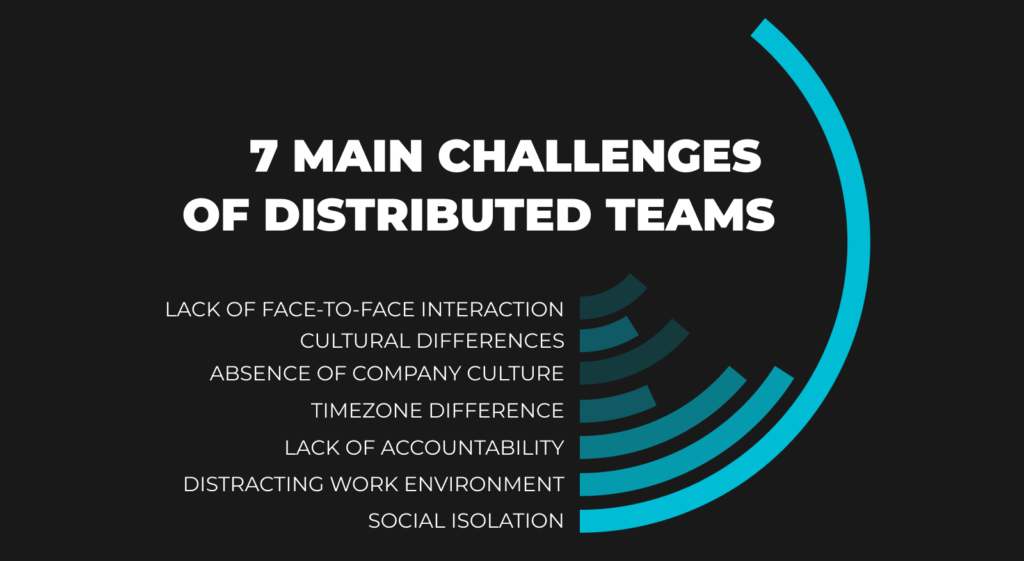Agile Distributed Teams Challenges and How to Handle Them and Mitigate
At the present time, an increasing number of tech projects are combining remote talents with agile methodology to ensure better and faster product delivery. A survey published in 2022 proved this notion. Over 80% of the respondents confirmed that they use agile best practices with their distributed teams across borders and time zones. This means an entity in New York can easily collaborate with a dedicated development team from Ukraine or another country.

However, though the concept of “agile distributed teams” changes how companies plan, build, and deliver their products, there are still some challenges with this methodology.
So, what are the challenges for the distributed team in agile and how can they be resolved? Read on to find out from this article.
Now, first things first….
What are Agile Distributed Teams?
Agile distributed teams are workers who are geographically dispersed but can work together effectively using agile principles and practices. This model is becoming increasingly popular as more and more companies embrace remote work.
At Newxel, we have the skills, experience, and resources to help you get a remote virtual team up and running, using agile best practices.
This model is often used by companies to complete software development projects, where they need to work with multiple people at different times of the day. This allows them to be more flexible than traditional office environments and allows for a more productive environment. Learn more.
When it’s Beneficial to Hire Distributed Teams Working Agile
There are some general situations when it’s beneficial to hire an agile distributed team.
For example, if you need to get a project up and running quickly, an agile team can be a great option. You don’t need to search for, recruit, and train local talents. Simply connect with any of the experts on standby in different parts of the world. They can help you hit the ground running and get things done quickly, resulting in faster time to market.
Also, if your product requires specialized skill sets that are not available in-house or locally, then using an agile distributed team makes sense. Employing distributed teams allows you to tap into a larger talent pool regardless of location. With access to a global talent pool, you have a better chance of finding the best people for your project.
Additionally, if you’re working on a complex project that requires a lot of coordination, an agile team can be a good choice. Hiring agile distributed teams lets you leverage agile methodologies, which facilitate faster iterations, shorter feedback loops, and shorter development cycles. This can result in faster turnaround times and better productivity, which is a critical factor for many businesses. The key to success though is proper knowledge of how to manage remote development team.
What Challenges with Distributed Team in Agile You Can Face
The distributed model has indeed been gaining in popularity in recent years as more and more companies adopt remote work policies. However, this model of work presents several challenges that must be addressed to be successful. Some of the top problems of distributed agile teams are:

Lack of face-to-face interaction
According to a recent survey, 27% of respondents say that the lack of face-to-face interaction is one of the biggest challenges of working with distributed agile teams. Instead of being able to do face-to-face meetings with the home office, project lead, or project owner, agile distributed teams often communicate via email or text message. This can be difficult for some people, especially those who prefer in-person interaction.
Adjustment to cultural differences
Another challenge with agile distributed teams is how they adjust to cultural differences. When members are located in different parts of the world, there can be differences in how things are done and what is considered important. This can be a challenge for team members who are used to working in a certain way.
Absence of company culture
The absence of company culture is also one of the challenges with agile distributed teams. In a traditional office setting, company culture is often communicated through things like dress code, office decor, and company values.
Remote workers can miss out on these important cues if they are not actively seeking them out. Additionally, team-building activities that help to foster a sense of camaraderie and trust can be more difficult to organize and execute when members are not all in the same location.
Timezone difference
Depending on the location of team members, there may be a significant time difference between members which can make coordinating work hours and deadlines difficult. Additionally, members in different time zones may find it hard to communicate with one another in real time.
Lack of accountability in productivity
Accountability is often one of the biggest agile distributed teams challenges. Without a clear centralized authority, it can be difficult to hold members accountable for their work. This can lead to a decrease in productivity and an increase in frustration.
Distracting work environment
Another common challenge is distractions. When members are working from home or in other remote locations, it can be easy for them to get distracted by household chores, children, or other obligations. This can lead to less focus on their work and, ultimately, lower productivity.
Social isolation
Working remotely can be a lonely experience, and team members may not have the opportunity to interact with one another on a personal level as they would in an office setting. This social isolation — experienced by about 70% of remote workers, according to a 2020 survey conducted by OnePoll — can lead to feelings of disconnection and disengagement from the group.
Notwithstanding these challenges with distributed agile teams, this work model can be successful, provided the necessary efforts are made to overcome the challenges.
How to Solve the Problems of Agile Distributed Teams and Improve Efficiency
While the distributed agile team challenges covered in the previous section might appear daunting, there are ways to overcome them. The following tips will help you solve them and improve your knowledge of how to manage offshore development team in the process:
Lack of face-to-face interaction
- Develop a clear and concise communication plan that everyone on the team understands and agrees to. This will help avoid confusion and miscommunication.
- During meetings, use video conferencing tools to build relationships, answer questions, and have more personal interaction.
- Organize once-in-a-while face-to-face meetings to maintain a strong connection between members.
Cultural differences
- Embrace cultural diversity and encourage members to share their practices and backgrounds.
- Understand the cultural differences of everyone on the team, and respect those differences. Try to find common ground and build on that.
- Ensure an inclusive environment in which diversity is valued and communication and collaboration are encouraged.
Absence of company culture
- Create a team culture that everyone can buy into. This can be done through team building exercises, social events, and creating shared values.
- Ensure the team is aligned around a shared vision and values
- Build a sense of belonging and ownership among members by encouraging them to share their experiences and ideas
Time zone differences
- Overlap working hours to accommodate time zone differences among team members
- Keep meetings and deadlines on track with scheduling tools
- Make sure you communicate clearly and provide updates regularly in order to avoid delays and misunderstandings
Lack of accountability in productivity
A good way to help address this problem is to create clear expectations for each team member.
- What is the minimum amount of work that you expect them to complete each week?
- What deadlines do you need them to meet?
When you have clear expectations, team members are more likely to meet them.
Distracting work environment
- Encourage team members to work in a dedicated area free from noise.
- Team members can wear noise-canceling headphones to shut out background noise and create a calmer, more concentrated workplace.
- Provide clear guidelines for the team about working hours, turnaround times, and communication techniques.
- Help team members to manage their work schedules and maintain concentration by using time-management strategies.
- Urge your team members to take regular breaks and exercise.
Social isolation
- Encourage bonding and social engagement by organizing virtual team-building events, casual conversations, and non-work-related talks.
- Encourage members to talk about their interests and hobbies in order to form personal bonds.
- Provide mental health assistance and resources to members to assist them in coping with the problems of remote work and social isolation.
Now that you know the challenges of how to manage a distributed team and their solutions, your workers can operate more efficiently and collaboratively, regardless of location or other challenges.
Some best practices that can also help mitigate the challenges with distributed teams working agile and help them work more efficiently are:
Ensure that work is evenly distributed
While working in distributed teams, it is important to ensure that everyone is aware of their tasks and that the workload is evenly distributed. Using project management tools that provide real-time monitoring and reporting of project progress is one way to achieve this. These tools can also uncover any workload mismatches and enable necessary corrections.
Organize paired coding
Pair coding can be a powerful tool for facilitating collaboration and information exchange in Agile distributed teams. Used properly, it can help resolve multiple distributed agile development challenges at a go.
People can benefit from the diversity of experience and views by pairing members with diverse talents and backgrounds, and they can work together to solve issues and perform tasks more quickly.
Implement and reinforce agile practices
Agile approaches are designed to facilitate teamwork, collaboration, and continual improvement. To successfully adopt agile principles in distributed teams, it is important to define communication procedures, such as frequent sprint reviews, and collaborative strategies.
Members should be encouraged to adopt an agile mentality, and scrum masters or project leaders must check to ensure the adoption of these techniques and make them routine for developers to keep the project on schedule.
Newxel’s Experience and Tips for Successful Work With Agile Distributed Teams
The world of work is changing. With advances in technology, more and more businesses are going global and looking to work with offshore teams. For software projects, there’s no question that this can be a great way to get work done. But what if you’re not sure where to start? That’s where we come in here at Newxel. We can help you build an agile distributed team that can get the job done, no matter where you are.
Newxel is a worldwide one-stop shop that provides a wide range of R&D and IT staff augmentation services to help your company grow. Newxel has assisted organizations and creative startups from all over the world in establishing software development teams and R&D facilities across the world.
Our services are built on the principles of flexibility and transparency which are strengthened by our skill and wide knowledge. We have representative offices in Europe, the United States, and Israel, as well as various development sites in Ukraine, Romania, and Poland, so we are well-positioned to help you create the perfect team for your projects no matter where you are and where you need them.
We have a deep understanding of the challenges in distributed agile development — from time zone differences to communication tools to culture fit — and can help you overcome them, and build the best team possible.
Our service enables you to manage your agile development process effectively, collaborate seamlessly with your distributed team, and deliver quality software on time.
Conclusion
Distributed teams working Agile are not just a great way to get work done quickly and efficiently, this model can also help you get access to top experts from different countries of the world. However, there are a few challenges that come with dealing with a distributed team, some of which we have explored in this article.
To recap, the most common challenges of agile teams working distributed are cultural differences, time differences, and communication difficulties.
These challenges can be mitigated by careful planning and setting up clear communication channels, but most importantly, by working with the right partner that can help make both the recruitment and management process seamless, efficient, and hassle-free. At Newxel, we deliver all of these and more. If you’re looking to set up an offshore team for agile development, contact us today. We can help you overcome any challenges





